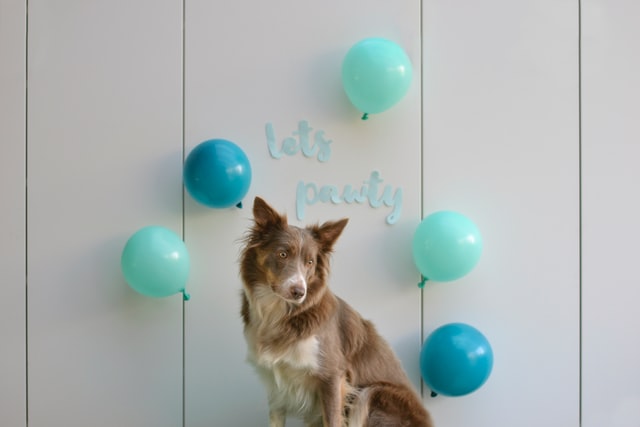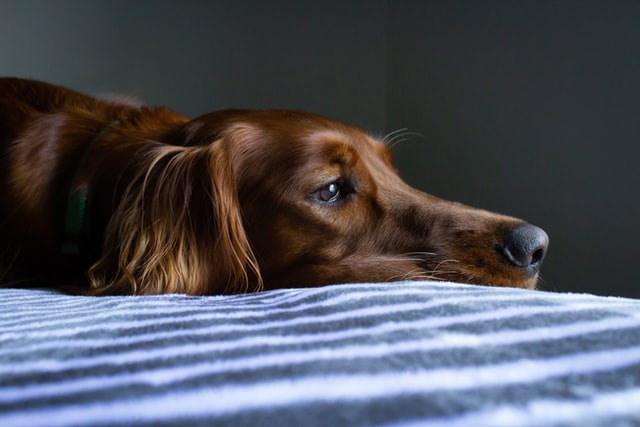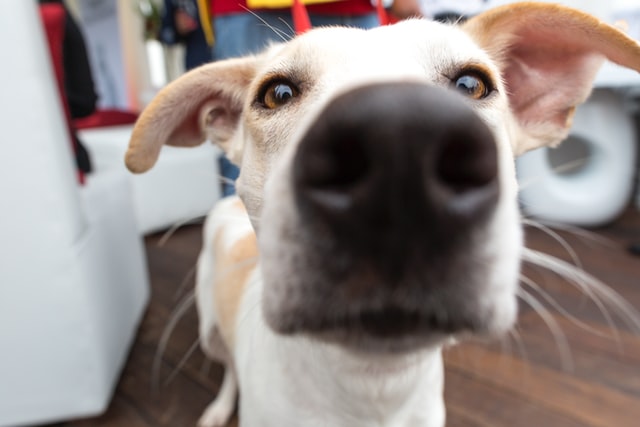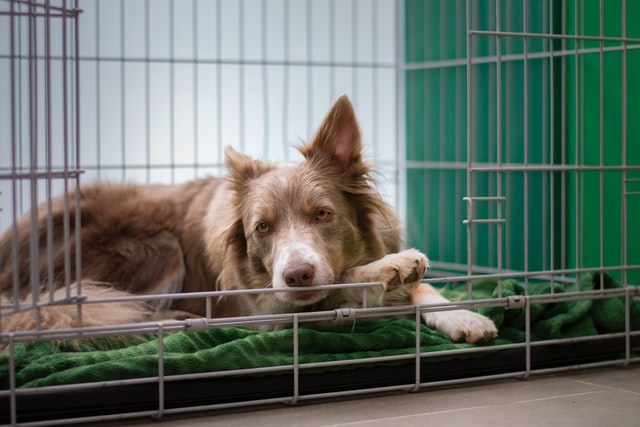Signs that indicate your dog has separation anxiety.
As you’re getting ready to leave the house, have you noticed that your dog’s behavior changes?
You wouldn’t be the only one as more and more pets are being diagnosed with unwanted behaviors that stem from anxiety.
If you’re concerned about your dog’s change in personality or behavior when it comes to you leaving for work, then keep reading to learn more about the signs of separation anxiety and some ways that you can help at home.
What Is Separation Anxiety In Dogs?
Separation anxiety in dogs is a condition where a pet becomes so stressed and overwhelmed by being separated from their owner that they then display distress behaviors.
Often when a dog is upset and showing separation anxiety behaviors, they will do the following:
- Excessive drooling
- Excessive panting for no medical reason
- Pacing and restlessness at the time of departure
- Vocalization
- Frantic escape attempts
- Inappropriate urination or defecation
- Destructive behaviors such as chewing, shredding or digging
- Vomiting or loss of appetite for no medical reason
- Self-trauma
According to a recent study, 14-20% of dogs showed separation anxiety.
How Old Are Most Dogs With Separation Anxiety?
Most dogs will begin to show symptoms of separation anxiety between the puppy years to age two.
Less often does an older dog that has never experienced separation anxiety develop it later in life.
How Do You Know If It’s Mischief Or Separation Anxiety?
Young dogs that are allowed too much freedom when unsupervised can be expected to get themselves into some trouble.
As a matter of fact, if you leave a dog under the age of a year un-kenneled and alone, you should be more surprised if you find the house in good shape than the other way around.
However, it is important that you understand the difference between a dog being bored and a dog that is suffering from a distressing condition such as separation anxiety.
The thing is, separation anxiety is a serious condition that extends beyond the occasional unhappy whimper as you leave the house or the tattered sock that awaits your return.
Separation anxiety is not the same as boredom, and unlike a little mischief when your dog is left alone, it is caused by actual stress.
If you suspect that your dog’s recent destruction is from anxiety, make sure it’s not a case of insufficient training before categorizing ruined pillows or potty accidents as such.
There are always things to consider, like if there are other symptoms of separation anxiety that coincides, or perhaps the age the dog is and training that it has had.
To know for sure, audio or videotaping your dog’s behavior while you’re away is one of the finest methods to see what’s going on while you’re not at home.
How To Help With Dog Separation Anxiety
One of the key bits of advice that any canine or animal behaviorist will tell you is that patience is everything.
Trying to fix a psychological issue such as separation anxiety can be very difficult in the more severe cases, which is why it is so important to recognize the symptoms as early as possible and remain patient during the training process.
There are several behaviors that indicate separation anxiety in dogs, however, there are some that are more prominent, such as barking, destruction and excessive pacing.
Since these are seen the most often, let’s talk about how we can begin helping our dog’s anxiety and stress.
Barking
Excessive vocalization doesn’t seem like it would be a big deal since you’re not home, especially if that’s the worst that it gets with your dog.
However, it’s certainly no fun being neighbors or roommates with a dog that barks its head off once the owner leaves.
To help with unwanted barking once you’ve left the house, it can help to leave enrichment to distract your dog.
This could range from some of their favorite toys to puzzles with treats hidden inside to fun interactive toys that spit food out.
While it may not last the entire day, it helps to reduce the stress and anxiety that they feel upon that initial moment of you leaving the house.
Leaving a radio or television playing soothing music or maybe even your voice, could help ease your dog’s anxiety when you depart every day.
Some dog’s enjoy watching doggy TV channels too!
Pacing And Restlessness
When a dog begins pacing and acting restless, especially as you are going through your morning routine to leave the house, it would be likely that your companion is experiencing some separation anxiety.
This symptom may not always go noticed unless it is seen by another family member or caught on camera.
This is because the dog usually stops the behavior once the owner is home and if that is the only symptom of anxiety then their person would have no idea.
Going on a long walk prior to leaving should help to ease the pent up, anxious energy they are experiencing.
While this doesn’t work to help every dog, it certainly is still a good source of exercise.
Which is also good for the brain!
If your dog is pacing and restless often, even when you are home, it is worth taking them to the vet.
This could be a symptom of other issues such as pain or arthritis and cognitive dysfunction.
Destructive Behaviors
Destructive behaviors tend to be the more commonly complained about issues with separation anxiety.
Obviously, no one wants their house torn up every time they leave, only mounting to the anxiety in the household as the owner is now nervous and worried.
Even if a dog is left in a kennel, their destructive behavior can end up getting them hurt as they can break teeth, nails or even their jaw by chewing on the bars to escape.
Sometimes these anxiety episodes can end up with doors, drywall or even couches being destroyed.
To help handle destructive behaviors, it is best to designate a safe place to keep your dog.
This can be a kennel (most recommended by behaviorists and trainers) or a single room.
If the kennel triggers your dog’s anxiety even further, then try using a smaller room instead.
It is important that you have control over what is in that room so that your dog can’t destroy any items you’re trying to keep safe.
Keep your dog entertained with chewable toys, puzzles and interactive cameras or treat dispensers.
You can also play soothing music or television shows that can distract your dog and ease their anxiety.
Again, this is where patience is extremely important.
Destructive behaviors are extremely frustrating and can take time to get a handle on.
It is often recommended that you see a board certified veterinary behaviorist over unresolved issues with separation anxiety or if the pet becomes aggressive.
Are There Ways To Prevent Separation Anxiety In Dogs?
Absolutely!
However, that doesn’t mean that even if you take every preventative measure that it’s impossible for your dog to develop separation anxiety.
But let’s talk about the ways that you can certainly help.
Create A Routine
A daily routine helps your dog to establish and expect a regular series of events.
By default, this prepares them to understand what is going to happen each day and to adjust to the routine.
They know that they will get up in the morning, eat, go on a quick potty walk and their owner will leave. They expect it, therefore, it does not bother them.
Dogs that don’t have a routine can end up feeling anxious, not knowing when their owner will leave or return.
This impending doom of unknowingness is terrible to some dogs and it sends them into a panic anytime their owner leaves.
Encourage Independence
While some owners can find it distressing to have their dog alone in the backyard or doing their own thing while they do theirs, this independence is truly important for the pet’s mental health.
When we insist on our dogs spending every waking moment by our sides, we are only setting them up for an anxiety attack anytime you leave them alone.
Even with the little purse dogs, they need to be alone sometimes.
If they’ve never been independent, this will be a huge shock to their system when it finally happens.
Don’t Make Coming And Going A Big Deal
That’s right! I said don’t praise your dog like crazy and become overjoyed when you get home to your furry best friend.
This human behavior is what invites future separation anxiety because it teaches your dog that the moment you come home it’s all about them and you are both so overwhelmed with happiness it’s amazing.
So, what happens when you leave?
They are full of anxiety, wondering when their next overjoyous celebration of you coming home will be.
The same thing applies with departing!
Don’t act sad and give them lots of attention in the hopes that they won’t be upset when you leave. You’re just going to do the opposite.
The best thing to do is simply do your normal routine, practically ignore your dog and gather your stuff and leave.
That’s it.
No dramatic goodbye, no ecstatic hello.
The more boring the better.
Your Dog Has Separation Anxiety - It Can Be Managed
Try not to panic if you notice your dog is showing some signs of separation anxiety,like drooling, barking, having potty accidents or tearing up your favorite sunglasses.
It is a common condition and can be easily quelled with some patience and consistency.
Don’t hesitate to reach out to your veterinarian or a board certified behaviorist if attempts at helping your dog’s anxiety have been unsuccessful.





